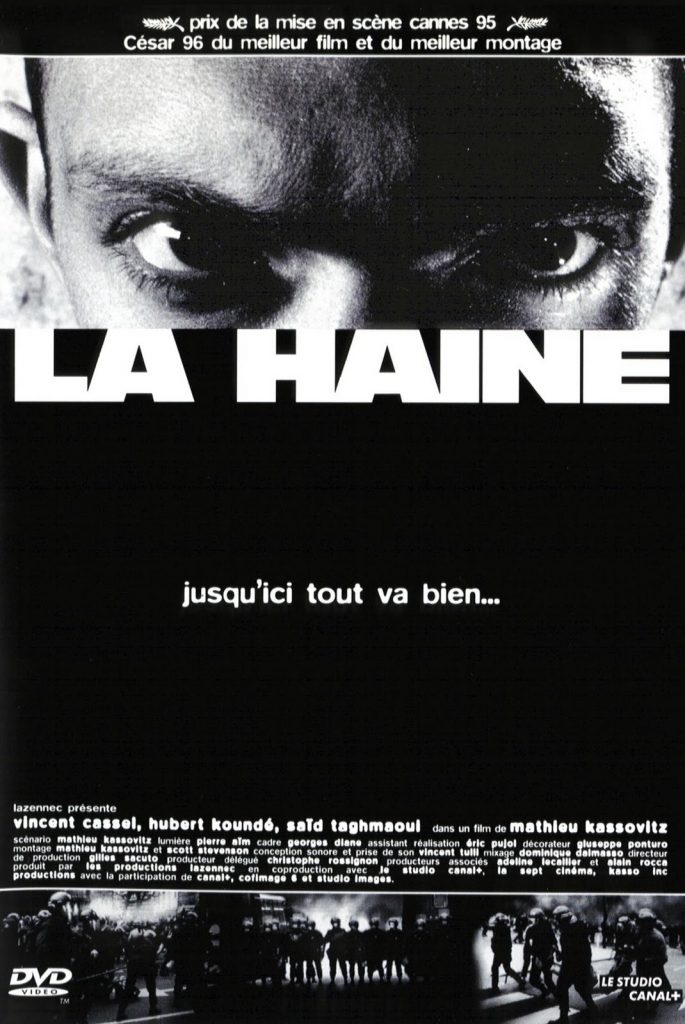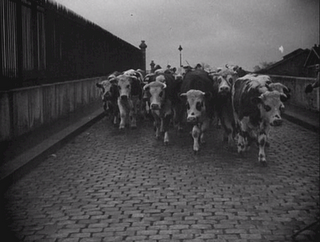One of the most enigmatic scenes in Mathieu Kassovitz’s La Haine, an exploration of social tensions and police brutality in the banlieues (council estates) of Paris in the 1990s, occurs the afternoon after a riot breaks out in the suburb the previous night. The sound of a hip-hop remix reverberates around the buildings, as a medium shot zooms in on Vinz (Vincent Cassel) and Saïd (Saïd Taghmaoui) looking up around them trying to locate the source of the music. Vinz then turns to look almost straight towards the camera and expresses dumbfounded surprise, as we cut to a long point-of-view shot of a cow crossing his field of vision. The cow seems to turn its head towards the camera (and towards Vinz) before casually wandering towards the right of the frame. We then cut back to the previous shot as Vinz exclaims that he has seen a cow, but Saïd dismisses his absurd notion: “Ta geule avec ta vache.” (“Shut up about your cow.”) Vinz continually insists he’s seen the cow as they walk away from the camera. As Vinz turns back to get one last glimpse, we hear a moo from the cow.
The absurdity of this encounter arises from the understanding that it is fairly unusual to see a living farm cow within an urban environment such as the banlieue. The sense of alienation implied is reflective of the disillusion felt by the characters with regards to their surroundings and social situation. This is further conveyed by the cow being framed on both sides by grimy and graffiti-covered concrete walls, suggesting a notion of entrapment within the estate – they are cut off from the idyllic, liberating and plentiful environment of the rural outdoors (as symbolised by the farm animal). The possible presence of the animal within this confined location evokes an image of the human residents within a socially stratified type of zoo – an idea suggested earlier in the film when Vinz shouts to a news crew attempting to film them on a road overhead “On n’est pas Thiory” (“This isn’t Thiory” – a safari park in France). This animal encounter achieves a similar effect to Georges Franju’s 1949 short film Le Sang des Bêtes (Blood of the Beasts), in which life in the outskirts of post-war Paris is compared to conditions inside a nearby slaughterhouse
The idea of the cow is introduced earlier in the film when we meet Vinz in his bedroom: he tells Saïd that the night of the riot he saw a cow in the estate; his friend replies by saying he should “stop smoking” because “it’s not doing you any good.” The implication here is that Vinz’s first sighting was a hallucination brought on by the marijuana he’s been smoking. Kassovitz employs cinematographic effects throughout the film to add ambiguity to Vinz’s perspective. For example, we never see Vinz and the cow in the same shot – we only see the animal from Vinz’s point of view. On the other hand, we still hear the cow during the shot in which both men are walking away, but only once Saïd’s back is turned. The image of the cow foreshadows the more absurd hallucinations Vinz will experience later on, reflecting the extent of his unhinged mentality during the course of the film.

